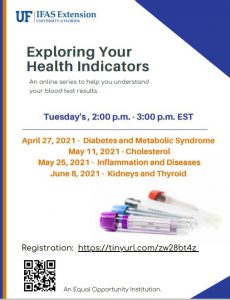by Heidi Copeland | May 15, 2021

American Rescue Plan: Enhanced Child Tax Credit
It is not often (or ever) that working families receive a windfall. Nevertheless, that is exactly what the enhanced, Child Tax Credit as part of the American Rescue Plan is. Moreover, it is a significant chunk of money for many families to receive on a monthly basis. If you qualify for the payments start thinking now about what to do with the money. Without a plan for spending, this money might be spent before you realize it!
The credit amount will be made through advance payment starting July1, 2021 ending December 31, 2021. This tax law change can be a boon to struggling families. Families can receive financial assistance now, rather than waiting until the 2022 tax filing season to receive the Child Tax Credit benefits. Please try to be mindful of this money. Start with a plan. A spending plan, also called a budget, is simply a strategy you create that helps you meet expenses. A good spending plan can keep you from spending money without thinking.
The credit is now extended to Puerto Rico and the U.S. Territories. For the first time, families residing in Puerto Rico and the U.S. Territories will receive this vital financial assistance to better support their children’s development and health and educational attainment
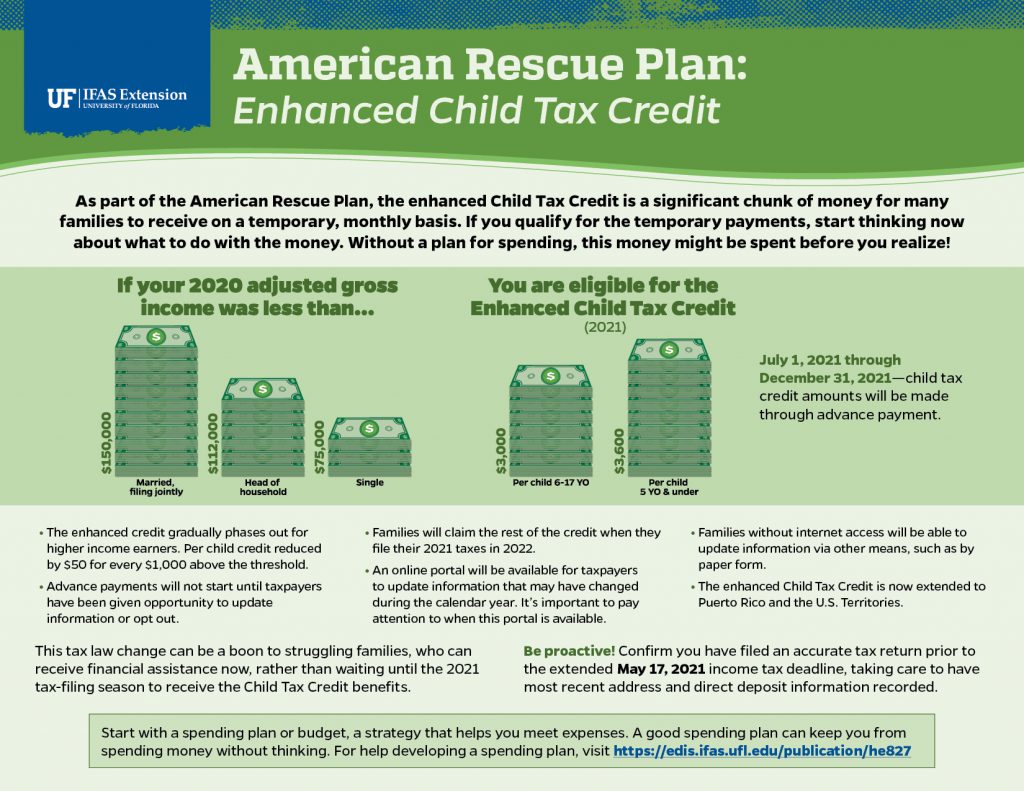
Leon County Child Tax Credit Infographic

by Samantha Kennedy | May 13, 2021

Samantha Kennedy, FCS Agent
(Source: Samantha Kennedy)
Samantha Kennedy is the Family and Consumer Sciences Agent in Wakulla County, FL. She specializes in health and wellness programming – healthy cooking, nutrition, and food safety – and is working to expand her expertise in financial education by studying to become an Accredited Financial Counselor (AFC).
Samantha – Sam, to her friends and family – received two degrees from the University of Florida (Go Gators!): a B.S. in both Microbiology and Cell Science and Nutritional Sciences in 2000 and an M.S. in Agricultural Education and Communication in 2002. With the exception of a couple of years right after grad school, Sam has proudly been a student at or faculty member of UF for nearly 25 years.
Sam began her Extension career in 2004 as the Family and Consumer Sciences Agent in Manatee County, FL, where she specialized in nutrition, chronic disease management, food safety, and home energy efficiency. In 2013, she became the County Extension Director in Manatee County and served in that role until November 2016, when she left southwest Florida for the beautiful Florida Panhandle.

Sam loves baseball. So far she has visited more than 20 major league ballparks. Visiting all 30 is definitely on her bucket list. (Source: Samantha Kennedy)
Hands-on teaching and live demonstrations are Sam’s favorite part of being an Extension Agent. She loves interacting with clientele and teaching them new skills while having fun. The Kitchen Creations day camp she holds each summer has been a great success. Seeing the kids engaged and excited about cooking and providing them with skills they will use for the rest of their lives is very rewarding.
Other Family and Consumer Sciences programming that Sam has been involved with over the years includes: Keeping the Pressure Down, Take Charge of Your Diabetes, Let’s Walk Florida, Walk Across Wakulla, Cooking with Herbs, Cheese Making, Home Canning, One-Pot Meals, The Art of Air Frying, Volunteer Income Tax Assistance, and the Manatee Energy Efficiency Project, just to name a few.
Sam was born in central Michigan, but moved with her family to south Florida when she was four, after her dad decided he was never shoveling snow ever again. When she was around seven years old, her family moved to west Arkansas (where it snows, yes, but not like Michigan), where they lived for about two years before heading back to Florida for good (well, sort of). She spent the rest of her childhood and adolescence in Deerfield Beach, FL and graduated from Deerfield Beach High School in 1995 (Go Bucks!).

Sam works to keep her cats in the lifestyle to which they have become accustomed. Clockwise from top left: Wesley (aka “Old Man”), Simon (aka “Mr. McNaughty Pants”), Lucas (aka “Squooshy,” may he rest in peace), and Porter (aka “Floofmaster P”).
(Source: Samantha Kennedy)
After graduate school, Sam moved to Katy, Texas and lived with her brother and his family for nearly two years, until she applied for and was hired for the Family and Consumer Sciences Agent position in Manatee County. Boy, was she glad to be back in Florida! Sam has lived all over the state: north central, south, southwest, and now northwest, but there is still a lot of this beautiful state she has left to see (e.g. she has never been to the Keys, if you can believe that!).
Sam’s cats (“the boys”) are the best cats in the entire universe (though she may be a bit biased). She likes to joke she runs a retirement home for cats, since they range in age from 13 to nearly 21 years old, but she would not trade a moment of it. When she is not working to support her feline family, she enjoys reading for pleasure, taking walks, journaling, hand lettering, and napping. Sam is also a huge baseball fan (Go Rays!), and has visited over 20 major league ballparks with plans to visit all 30 before the zombie apocalypse comes.

by Samantha Kennedy | May 13, 2021
I would like to continue on the theme of reducing food waste by talking more specifically about ways to use food scraps effectively to prevent them from ending up in the landfill.
As I was thinking about this topic, I was reminded of a funny scene from the 1982 film Night Shift, where Michael Keaton’s character, Billy Blaze, says into his tape recorder, “Idea to eliminate garbage: edible paper. You see, you eat it, it’s gone. Eat it, it’s out of there. No garbage.” Think about how much less waste would go into our landfills if we could just eat paper!
It is the same concept for food waste. As much as 40% of food grown, processed, and transported in the United States will never be eaten, destined to end up in the landfill. That is literally thousands of tons of food wasted each year. But what if we could help reduce that amount?
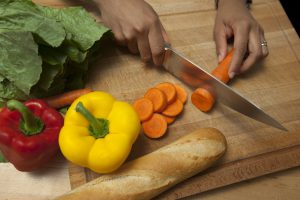
Got leftover veggie scraps? Instead of throwing them away, save them for a delicious veggie soup.
(Photo source: UF/IFAS)
Here are two great ideas for using leftover food scraps instead of throwing them away.
Cook with them. Leftover vegetables are great ingredients for a simple and delicious soup. Simply take the leftovers, combine them with an aromatic base of onions, garlic, and celery, add a liquid such as stock or broth (or water and white wine), throw in a generous helping of herbs, and cook for about 25-30 minutes. Then use an immersion blender or food processor (or stand-up blender) to blend into a creamy soup. Any type of vegetable works for this type of soup, from greens and cauliflower to parsnips and sweet potatoes, which makes it an ideal way to use up those scraps.
Another great way to use vegetable scraps is to make homemade stock. Vegetable parts such as carrot ends and peels, celery ends and greens, corn cobs, pea pods, and all the other bits trimmed off during food preparation can be used to make stock. Not in the mood to make stock right away? No problem! Veggie scraps can be saved in a zippered bag and kept frozen for up to six months.
When the time comes, simply dump the scraps into a large stock pot (that is why it is called a stock pot!) or Dutch oven, fill the pot 3/4 of the way with water, bring to a boil and simmer for at least 30 minutes. (The longer it simmers, the richer the flavor.) Strain it all through a sieve. The remaining liquid is the stock. Fresh stock can be stored 3-5 days in the refrigerator or frozen up to three months. Here is a simple resource from Cornell University Extension on how to make vegetable stock from kitchen scraps. (Here is another one from Tasty.co.)
Hold on! There are still scraps left over. What about those? Well, that brings me to the second great way to use kitchen scraps.

Food waste such as vegetable scraps can be added to compost to create a nutrient-rich fertilizer for home gardens.
(Photo source: Tyler Jones, UF/IFAS)
Compost them. Creating compost at home takes a little work and perseverance, but it can certainly pay off in the home garden. Nutrient-rich compost can add oomph to flower beds and vegetable patches and turn any garden into a showcase.
Vegetable scraps are perfect additions to any compost pile. Any vegetable scraps can be added to compost. Just remember to remove the little stickers, as those are not compostable.
According to the Environmental Protection Agency (EPA), there are many benefits to compost. It enriches soil, helping retain moisture and suppress plant diseases and pests. It reduces the need for chemical fertilizers. And it encourages the production of beneficial bacteria and fungi that break down organic matter to create humus, a rich nutrient-filled material. These fact sheets (this one and this one) from UF/IFAS Extension are a wealth of information about home composting.
The reduction of unnecessary food waste begins with us, the consumers. By learning how to use those scraps in useful ways, such as cooking and composting, we can help eliminate the excess food waste filling our landfills.
UF/IFAS is an Equal Opportunity Institution.

by Judy Corbus | May 12, 2021
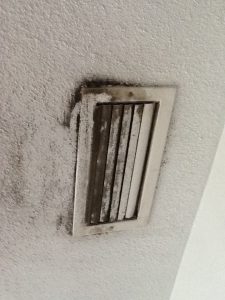
Removing the moisture source is the first step in combatting mold. Photo source: UF/IFAS Extension Pinellas County
Have you seen black, gray, white, or orange stains on your bathroom tile’s grout? Does it look slimy or cottony? Well, you guessed it—that’s mold. There are good molds – yogurts, cheeses, and antibiotics – and bad molds, like the kind that grows in the bathroom.
Mold and mildew refer to a fungus that flourishes in warm, humid, indoor environments. Florida’s heat and humidity supply the ideal habitat for molds of all kinds. Because mold reproduces by releasing spores into the air, mold can go undetected until it has grown into a colony, as in our grout example. Certain molds really are toxic, however, and not only cause health problems, but also damage building structures, furniture, books, and other items.
Health Impacts of Mold
Exposure occurs by touching mold or inhaling air containing its spores. Exposure may cause allergic symptoms and health problems, ranging from sneezing, coughing, or a runny nose to chronic sinus problems, nosebleeds, asthma, skin and/or eye irritation, headaches, difficulty concentrating, and even memory loss.
How to Prevent Mold
Mold is a part of nature and there is no way to keep it entirely at bay. However, we can limit its growth by keeping our house:
Cool – Keep the temperature below 77°F inside your home if you think mold might be an issue.
Dry – Keep the relative humidity below 60%. You can purchase an inexpensive humidity meter (hygrometer) from a hardware store.
- Dry wet surfaces or items as soon as possible. Do not leave anything wet for more than 24 hours.
- Wipe down shower walls with a window squeegee or towel right after showering.
- Fix leaks.
- Pull the shower curtain across the tub/stall to allow the curtain to dry.
- Run the bathroom exhaust fan while you are showering and up to 15 minutes after you finish or open the bathroom window to allow moisture to escape.
- If bath towels remain damp in your bathroom several hours after bathing, hang them in the garage or outside to dry. This reduces moisture in the bathroom and keeps towels from souring.
Clean – Keep your house clean to minimize nutrients for mold.
- Wipe countertops to remove any food residue.
- Refrigerate perishables. (This also reduces foodborne illness risk).
- Clean bathrooms – pay special attention to the shower/tub area and sink to remove soap scum and dead skin cell residue that some molds feed on.
- Change the air conditioner filter monthly.
Mold Removal
When you find mold inside your home, it means there is a moisture problem – leaky plumbing, a roof leak, or water entering around a window or door. Fix the source of the problem or mold will continue to be a problem. If you cannot find the source, if there has been a lot of water damage, or the moldy area is larger than 10 square feet (about a 3 ft. X 3 ft. square), it is recommended to get professional help.
To clean small areas, scrub the moldy surface with a solution of dishwashing or laundry detergent and water, or a mild solution of bleach and water. Wear waterproof gloves and protective goggles to protect your skin and eyes from direct contact with the mold. Wear an N-95 respirator (available at most hardware stores) to avoid inhaling the mold spores. After cleaning, dry the wet area thoroughly to prevent further mold growth.
For more information on controlling mold and mildew, contact your local UF/IFAS Extension Office.
Resource: Keeping It Clean: Controlling Mildew
Source: “Keeping Your Home Healthy,” Taking Good Care of My Home, UF/IFAS Extension.

by Dorothy C. Lee | Apr 29, 2021
Spring has arrived. It is fresh produce season. The USDA Dietary Guidelines recommend that half your plate should be filled with fruits and vegetables. Select a rainbow of colorful fresh fruits and vegetables to enhance your diet.
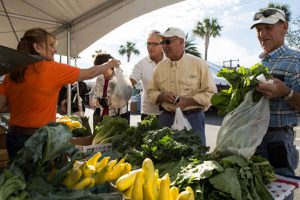
Keep It Fresh
Photo Source: UF/IFAS
There is a bountiful supply of fruits and vegetables during the Spring and Summer months. Grocery stores, famers markets, and backyard gardens abound with abundant supply of fresh produce.
Recently fresh produce has been linked to various outbreaks of foodborne illness. These problems are becoming more common and it is important as a consumer to know how to handle fresh produce safely.
Safe Produce Handling Tips
Purchasing
Purchase vegetables and fruits that look and smell fresh. Purchase only the amount you will use in a few days. Most vegetables and fruits with the exception of apples, potatoes, and citrus don’t store well for long periods of time.
Storing
Put produce away promptly. Most whole produce will keep best stored in perforated plastic bags in the refrigerator crisper drawer where the humidity is highest. Tomatoes and potatoes are two exceptions. Tomatoes taste better if stored at room temperature. Potatoes stay fresh longer if stored in a cool, dry, dark place. Cut produce should be stored in the refrigerator in covered containers. Bacteria can grow on cut surfaces of produce.
Washing
Rinse whole produce thoroughly under clean running tap water, just before you are ready to use. Do not wash fruits and vegetables with detergent. Scrub or rub as needed to remove surface contamination. Wash produce such as oranges and melons even if you don’t eat the rind or skin. When you cut into a fruit or vegetable, any bacteria that is on the surface can be transferred to the inner flesh. Check the label instructions on fresh bagged produce. For example; use by date, pre-washed, and ready to eat. Discard stored fruits and vegetables that appear moldy or smell musty.
It is essential to our health to preserve the nutrition that is found in fruits and vegetables. Fruits and vegetables contain an abundance of vitamins and minerals that the body needs to maintain optimal health. Following those easy safe produce tips can help preserve freshness and assure safe produce handling.

by Marie Arick | Apr 29, 2021

Openly discuss the physician’s care plan and seek answers to questions.
(Photo source: Tyler Jones, UF/IFAS)
The American Heart Association notes that cholesterol is “not inherently bad” and continues by explaining how cholesterol is necessary to “build cells, make vitamins and other hormones.”
Cholesterol is not only derived from your dietary intake, what you eat, but also your liver makes cholesterol. There are two types of cholesterol, low density lipoprotein or LDL and high density lipoprotein or HDL. The LDL or ‘lousy’ cholesterol contributes to atherosclerosis, the build up of fat in the arteries. The HDL or ‘helpful’ cholesterol aids with removing the lousy cholesterol out of the arteries and taking it to the liver for it to be removed from the body.
Being proactive with one’s health and knowing your numbers, one can better maintain a higher quality of life and potentially suffer less infirmities.
Join us for the upcoming Exploring Your Health Indicators Webinar Series to gain knowledge of your blood tests results. The May 11 program will explore cholesterol. The May 25 program dives into inflammation and diseases. And the June 8 program will wrap the series with kidney and thyroid health indicators. Register once for all the sessions and if you miss a session, a recording of the program will be emailed to you. Invest an hour to gain knowledge that can greatly benefit your health.
Exploring Your Health Indicators Registration: https://tinyurl.com/zw28bt4z
Tuesday, April 27, 2021, 2-3 EST/1-2 CST – Diabetes and Metabolic Syndrome
Tuesday, May 11, 2021, 2-3 EST/1-2 CST – Cholesterol
Tuesday, May 25, 2021, 2-3 EST/1-2 CST – Inflammation and Diseases
Tuesday, June 8, 2021, 2-3 EST/1-2 CST – Kidneys and Thyroid
